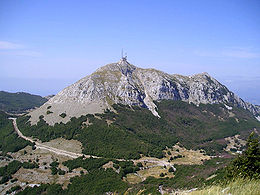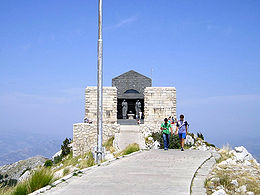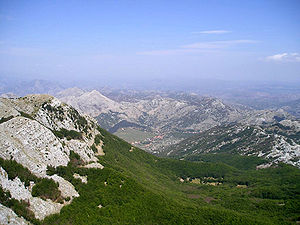
Mount Lovcen
Encyclopedia



National park
A national park is a reserve of natural, semi-natural, or developed land that a sovereign state declares or owns. Although individual nations designate their own national parks differently A national park is a reserve of natural, semi-natural, or developed land that a sovereign state declares or...
in southwestern Montenegro
Montenegro
Montenegro Montenegrin: Crna Gora Црна Гора , meaning "Black Mountain") is a country located in Southeastern Europe. It has a coast on the Adriatic Sea to the south-west and is bordered by Croatia to the west, Bosnia and Herzegovina to the northwest, Serbia to the northeast and Albania to the...
.
The Mount Lovćen rises from the borders of the Adriatic basin
Adriatic Sea
The Adriatic Sea is a body of water separating the Italian Peninsula from the Balkan peninsula, and the system of the Apennine Mountains from that of the Dinaric Alps and adjacent ranges...
closing the long ang twisting bays of Boka Kotorska and making the hinterland to the coastal town of Kotor
Kotor
Kotor is a coastal city in Montenegro. It is located in a secluded part of the Gulf of Kotor. The city has a population of 13,510 and is the administrative center of the municipality....
. The mountain has two imposing peaks, Štirovnik (1,749 m) and Jezerski vrh (1,657 m).
The mountain slopes are rocky, with numerous fissures, pits and deep depressions giving its scenery a specific look. Standing on the border between two completely different natural wholes, the sea and the mainland, Lovćen is under the influence of both climates. The specific connection of the life conditions has stipulated the development of the different biological systems. There are 1158 plant species on Lovćen, out of which four are endemic.
National park
National Park encompasses the central and the highest part of Lovćen mountain massif and covers an area of 62.20 km². It was proclaimed a national park in 1952. Besides Lovćen's natural beauties, the national park was established to protect rich historical, cultural and architectural heritage of the area.Lovćen's area abounds in numerous elements of national construction. The old houses and village guvna are authentic as well as the cottages in katuns – summer settlements of cattlebreeders.
A particular architectural relic worth mentioning is Lovćen's serpentine road winding uphill from Kotor
Kotor
Kotor is a coastal city in Montenegro. It is located in a secluded part of the Gulf of Kotor. The city has a population of 13,510 and is the administrative center of the municipality....
to the village of Njeguši
Njeguši
Njeguši is a village in southern Montenegro, within Cetinje municipality. It is located on the slopes of Mount Lovćen, within Lovćen national park....
, where the birth house of Montenegrin royal family of Petrović is situated.
Mausoleum Controversy
The biggest and most important monument of Lovćen national park is Njegoš's Mausoleum. The location for his burial place and the mausoleum at the summit of Jezerski vrh was chosen by Njegoš himself as his last wish.However, Njegoš's express wish was to be buried in a small chapel which he had built in his lifetime. This was done, but the original chapel was destroyed when the Austro-Hungarian army
Austro-Hungarian Army
The Austro-Hungarian Army was the ground force of the Austro-Hungarian Dual Monarchy from 1867 to 1918. It was composed of three parts: the joint army , the Austrian Landwehr , and the Hungarian Honvédség .In the wake of fighting between the...
invaded Montenegro
Kingdom of Montenegro
The Kingdom of Montenegro was a monarchy in southeastern Europe during the tumultuous years on the Balkan Peninsula leading up to and during World War I. Legally it was a constitutional monarchy, but absolutist in practice...
in First World War (1916). Njegoš's remains were then transferred into Cetinje Monastery
Cetinje Monastery
The Cetinje Monastery is the most famous Serb Orthodox monastery in Montenegro. It is located in Cetinje and is the seat of the Metropolitanate of Montenegro and the Littoral and its name derives from Saint Peter of Cetinje...
and buried in the chapel rebuilt by King Alexander
Alexander I of Yugoslavia
Alexander I , also known as Alexander the Unifier was the first king of the Kingdom of Yugoslavia as well as the last king of the Kingdom of Serbs, Croats and Slovenes .-Childhood:...
in 1920s. Contrary to Njegoš's express wishes to be buried in that chapel, the then communist powers of Montenegro destroyed the chapel and built in its stead a monumental mausoleum in Viennese Secession style. The local Bishopric (Mitropolija) of the Serbian Orthodox Church opposed the destruction and even took the matter to the Constitutional Court, albeit with no success. The design was that of Ivan Meštrović
Ivan Meštrovic
Ivan Meštrović was a Croatian and Yugoslav sculptor and architect born in Vrpolje, Croatia...
who, although world-famous, had never set foot on Lovćen.
The protests erupted in 1970 with many famous Yugoslav public figures, of both Montenegrin and non-Montenegrin origin, complaining of what they described as barbaric breaking of Njegoš's last will.
See also
- LovćenacLovcenacLovćenac is a village located in the Mali Iđoš municipality, in the North Bačka District of Vojvodina, Serbia...
, a village in the VojvodinaVojvodinaVojvodina, officially called Autonomous Province of Vojvodina is an autonomous province of Serbia. Its capital and largest city is Novi Sad...
named after the mountain by an influx of Montenegrins.

